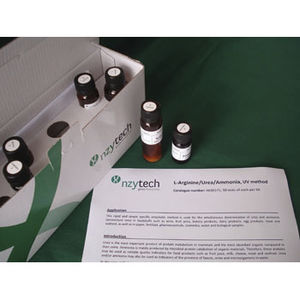
Research test kit AK00081for food safetyacetaldehydeacetic acid
Add to favorites
Compare this product
Characteristics
- Applications
- for research
- Application field
- for food safety
- Tested parameter
- acetaldehyde, acetic acid
- Sample type
- biological
- Analysis mode
- enzymatic
- Sample volume
2 ml
(0.06763 US fl oz)
Description
Enzymatic method for the determination of acetic acid. Based on the spectrophotometric measurement of NADH produced through the reactions, after addition of Acetyl-Co A synthetase (ACS), Citrate synthase (CS) and L-malate dehydrogenase (L-MDH)
This rapid and simple specific enzymatic method is used for the determination of acetic acid (acetate) in foodstuffs such as wine, vinegar, beer, dairy products, bread, fruit, fish, meat and vegetable, as well as in paper, animal feed (silages), pharmaceuticals and biological samples.
Acetic acid is a very important metabolite since it is the end product of fermentation processes and the oxidation product of acetaldehyde and ethanol. Acetic acid is the main component of the "volatile acids" in wine and one of the most important parameters of its quality control. A high concentration of acetic acid in wine results in spoilage of the product. Thus, there may be legal limitations in the acetic acid content. Acetic acid is used in food production as a preservative and a taste improver. Acetic acid is the compound determining the monetary value of vinegar.
The determination is specific for acetic acid. The sensitivity of the assay is based on 0.005 AU and a sample volume of 2.00 mL. This corresponds to an acetic acid concentration of 0.07 mg/L sample solution when measured at 340 nm. The detection limit of 0.14 mg/L results from the absorbance difference of 0.010 (340 nm) and a maximum sample volume of 2.00 mL.
More Information
Shipping Conditions
Room Temperature
Storage Conditions
2 °C to 8 °C
Application
Biofuel, Dairy, Feed, Fermentation, Food, Wine
Features
Detection limit: 0.14 mg/L, Range: 0.15-200 mg/L
Catalogs
No catalogs are available for this product.
See all of NZYTech‘s catalogsRelated Searches
- Assay kit
- Solution reagent kit
- Blood assay kit
- Molecular biology reagent kit
- Research reagent kit
- Infectious disease detection kit
- Protein reagent kit
- Diagnostic reagent kit
- Laboratory reagent kit
- Enzyme reagent kit
- Molecular test kit
- Respiratory infection test kit
- Histology reagent kit
- Optical assay kit
- Clinical assay kit
- Dye reagent
- Buffer solution reagent kit
- Fluorescence assay kit
- COVID-19 detection kit
- Quality control reagent kit
*Prices are pre-tax. They exclude delivery charges and customs duties and do not include additional charges for installation or activation options. Prices are indicative only and may vary by country, with changes to the cost of raw materials and exchange rates.





